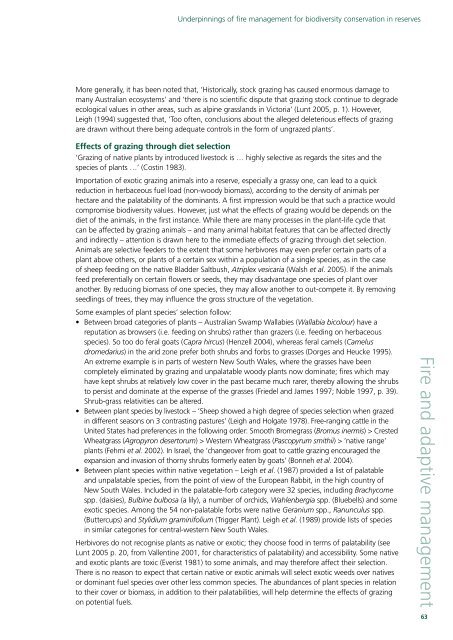Underpinnings of fire management for biodiversity conservation in ...
Underpinnings of fire management for biodiversity conservation in ...
Underpinnings of fire management for biodiversity conservation in ...
Create successful ePaper yourself
Turn your PDF publications into a flip-book with our unique Google optimized e-Paper software.
<strong>Underp<strong>in</strong>n<strong>in</strong>gs</strong> <strong>of</strong> <strong>fire</strong> <strong>management</strong> <strong>for</strong> <strong>biodiversity</strong> <strong>conservation</strong> <strong>in</strong> reserves<br />
More generally, it has been noted that, ‘Historically, stock graz<strong>in</strong>g has caused enormous damage to<br />
many Australian ecosystems’ and ‘there is no scientific dispute that graz<strong>in</strong>g stock cont<strong>in</strong>ue to degrade<br />
ecological values <strong>in</strong> other areas, such as alp<strong>in</strong>e grasslands <strong>in</strong> Victoria’ (Lunt 2005, p. 1). However,<br />
Leigh (1994) suggested that, ‘Too <strong>of</strong>ten, conclusions about the alleged deleterious effects <strong>of</strong> graz<strong>in</strong>g<br />
are drawn without there be<strong>in</strong>g adequate controls <strong>in</strong> the <strong>for</strong>m <strong>of</strong> ungrazed plants’.<br />
Effects <strong>of</strong> graz<strong>in</strong>g through diet selection<br />
‘Graz<strong>in</strong>g <strong>of</strong> native plants by <strong>in</strong>troduced livestock is … highly selective as regards the sites and the<br />
species <strong>of</strong> plants …’ (Cost<strong>in</strong> 1983).<br />
Importation <strong>of</strong> exotic graz<strong>in</strong>g animals <strong>in</strong>to a reserve, especially a grassy one, can lead to a quick<br />
reduction <strong>in</strong> herbaceous fuel load (non-woody biomass), accord<strong>in</strong>g to the density <strong>of</strong> animals per<br />
hectare and the palatability <strong>of</strong> the dom<strong>in</strong>ants. A first impression would be that such a practice would<br />
compromise <strong>biodiversity</strong> values. However, just what the effects <strong>of</strong> graz<strong>in</strong>g would be depends on the<br />
diet <strong>of</strong> the animals, <strong>in</strong> the first <strong>in</strong>stance. While there are many processes <strong>in</strong> the plant-life cycle that<br />
can be affected by graz<strong>in</strong>g animals – and many animal habitat features that can be affected directly<br />
and <strong>in</strong>directly – attention is drawn here to the immediate effects <strong>of</strong> graz<strong>in</strong>g through diet selection.<br />
Animals are selective feeders to the extent that some herbivores may even prefer certa<strong>in</strong> parts <strong>of</strong> a<br />
plant above others, or plants <strong>of</strong> a certa<strong>in</strong> sex with<strong>in</strong> a population <strong>of</strong> a s<strong>in</strong>gle species, as <strong>in</strong> the case<br />
<strong>of</strong> sheep feed<strong>in</strong>g on the native Bladder Saltbush, Atriplex vesicaria (Walsh et al. 2005). If the animals<br />
feed preferentially on certa<strong>in</strong> flowers or seeds, they may disadvantage one species <strong>of</strong> plant over<br />
another. By reduc<strong>in</strong>g biomass <strong>of</strong> one species, they may allow another to out-compete it. By remov<strong>in</strong>g<br />
seedl<strong>in</strong>gs <strong>of</strong> trees, they may <strong>in</strong>fluence the gross structure <strong>of</strong> the vegetation.<br />
Some examples <strong>of</strong> plant species’ selection follow:<br />
• Between broad categories <strong>of</strong> plants – Australian Swamp Wallabies (Wallabia bicolour) have a<br />
reputation as browsers (i.e. feed<strong>in</strong>g on shrubs) rather than grazers (i.e. feed<strong>in</strong>g on herbaceous<br />
species). So too do feral goats (Capra hircus) (Henzell 2004), whereas feral camels (Camelus<br />
dromedarius) <strong>in</strong> the arid zone prefer both shrubs and <strong>for</strong>bs to grasses (Dorges and Heucke 1995).<br />
An extreme example is <strong>in</strong> parts <strong>of</strong> western New South Wales, where the grasses have been<br />
completely elim<strong>in</strong>ated by graz<strong>in</strong>g and unpalatable woody plants now dom<strong>in</strong>ate; <strong>fire</strong>s which may<br />
have kept shrubs at relatively low cover <strong>in</strong> the past became much rarer, thereby allow<strong>in</strong>g the shrubs<br />
to persist and dom<strong>in</strong>ate at the expense <strong>of</strong> the grasses (Friedel and James 1997; Noble 1997, p. 39).<br />
Shrub-grass relativities can be altered.<br />
• Between plant species by livestock – ‘Sheep showed a high degree <strong>of</strong> species selection when grazed<br />
<strong>in</strong> different seasons on 3 contrast<strong>in</strong>g pastures’ (Leigh and Holgate 1978). Free-rang<strong>in</strong>g cattle <strong>in</strong> the<br />
United States had preferences <strong>in</strong> the follow<strong>in</strong>g order: Smooth Bromegrass (Bromus <strong>in</strong>ermis) > Crested<br />
Wheatgrass (Agropyron desertorum) > Western Wheatgrass (Pascopyrum smithii) > ‘native range’<br />
plants (Fehmi et al. 2002). In Israel, the ‘changeover from goat to cattle graz<strong>in</strong>g encouraged the<br />
expansion and <strong>in</strong>vasion <strong>of</strong> thorny shrubs <strong>for</strong>merly eaten by goats’ (Bonneh et al. 2004).<br />
• Between plant species with<strong>in</strong> native vegetation – Leigh et al. (1987) provided a list <strong>of</strong> palatable<br />
and unpalatable species, from the po<strong>in</strong>t <strong>of</strong> view <strong>of</strong> the European Rabbit, <strong>in</strong> the high country <strong>of</strong><br />
New South Wales. Included <strong>in</strong> the palatable-<strong>for</strong>b category were 32 species, <strong>in</strong>clud<strong>in</strong>g Brachycome<br />
spp. (daisies), Bulb<strong>in</strong>e bulbosa (a lily), a number <strong>of</strong> orchids, Wahlenbergia spp. (Bluebells) and some<br />
exotic species. Among the 54 non-palatable <strong>for</strong>bs were native Geranium spp., Ranunculus spp.<br />
(Buttercups) and Stylidium gram<strong>in</strong>ifolium (Trigger Plant). Leigh et al. (1989) provide lists <strong>of</strong> species<br />
<strong>in</strong> similar categories <strong>for</strong> central-western New South Wales.<br />
Herbivores do not recognise plants as native or exotic; they choose food <strong>in</strong> terms <strong>of</strong> palatability (see<br />
Lunt 2005 p. 20, from Vallent<strong>in</strong>e 2001, <strong>for</strong> characteristics <strong>of</strong> palatability) and accessibility. Some native<br />
and exotic plants are toxic (Everist 1981) to some animals, and may there<strong>for</strong>e affect their selection.<br />
There is no reason to expect that certa<strong>in</strong> native or exotic animals will select exotic weeds over natives<br />
or dom<strong>in</strong>ant fuel species over other less common species. The abundances <strong>of</strong> plant species <strong>in</strong> relation<br />
to their cover or biomass, <strong>in</strong> addition to their palatabilities, will help determ<strong>in</strong>e the effects <strong>of</strong> graz<strong>in</strong>g<br />
on potential fuels.<br />
Fire and adaptive <strong>management</strong> 63





![Metcalfe State Forest Fauna Species List [PDF File - 16.9 KB]](https://img.yumpu.com/22024301/1/184x260/metcalfe-state-forest-fauna-species-list-pdf-file-169-kb.jpg?quality=85)






![PPE Price List for Wildlife Volunteers [PDF File - 20.3 KB]](https://img.yumpu.com/15321634/1/190x135/ppe-price-list-for-wildlife-volunteers-pdf-file-203-kb.jpg?quality=85)




